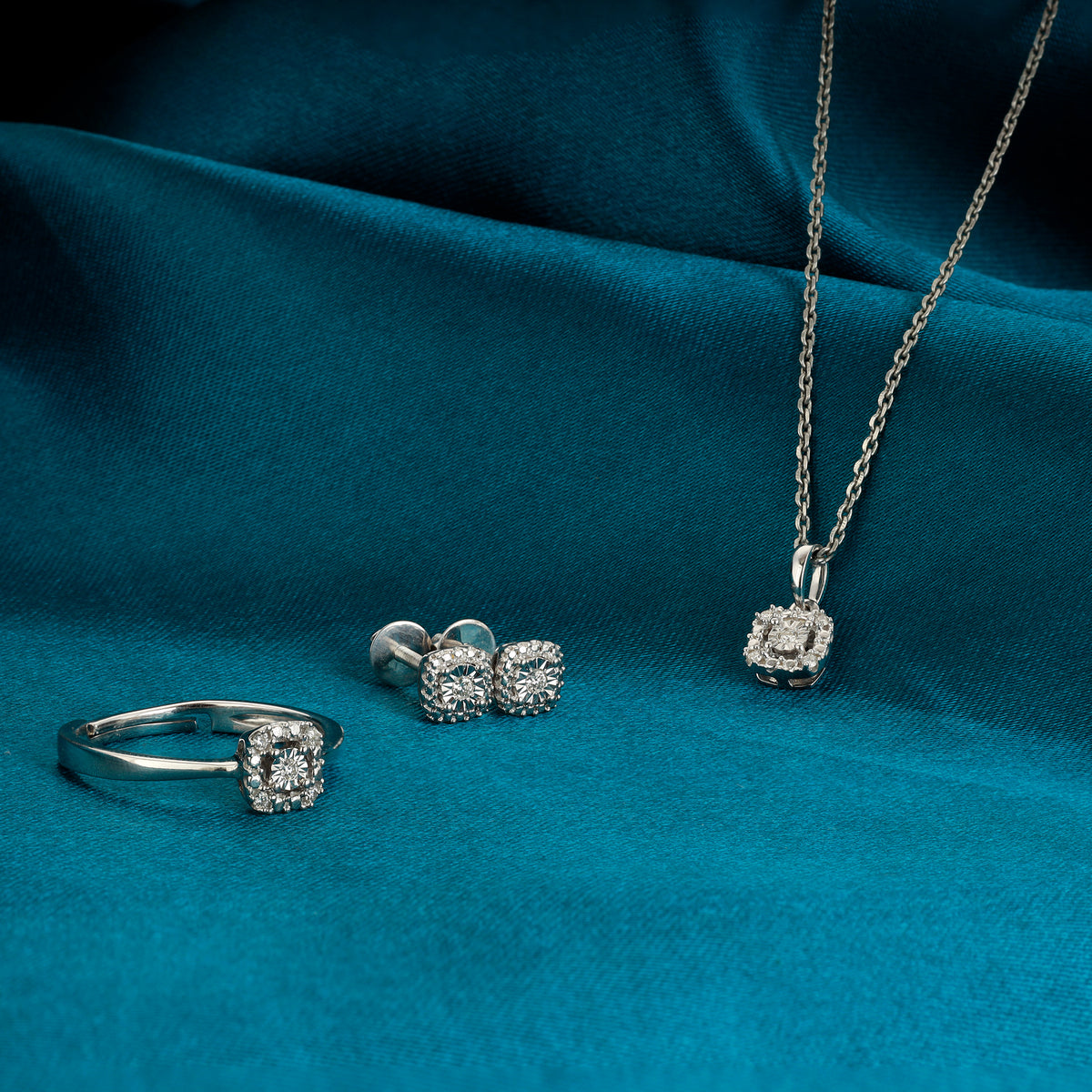When we think of precious stones, diamond is probably the first stone that comes to our mind. The shiny stone has captivated humankind for generations. Formed out of the most common substance on earth (carbon) under extreme pressure, high temperatures, and the test of time, it is no surprise that natural diamond jewellery is now a sign of enduring love and lasting commitment!
So let’s take a closer look at diamonds, understand what all the hype is about, and find out if there exists such a as thing called affordable diamond jewellery (spoiler alert: there is)!
What is a Diamond?

A diamond is a mineral that is composed purely of carbon atoms arranged in a crystal structure. It is the hardest naturally occurring substance on earth and is used for both industrial purposes as well as jewellery.
This precious stone is often considered one of the most coveted possessions one can own, be it in the form of a diamond ring, necklace, or even a pair of earrings! Diamond artefacts are passed on from generation to generation, signifying the precious stone’s lifetime durability.
Determining the value of diamond jewellery

It doesn’t take an expert to tell us that lab-grown diamond jewellery is highly valuable. But if you’re considering buying a piece of diamond jewellery, be it a ring for marriage or a pair of earrings to treat yourself, it always helps to understand what you are paying for.
A diamond’s value is universally determined by four factors, popularly called the 4 Cs: Carat, clarity, cut, and colour.
- Carat: This refers to the weight or mass of the diamond. One carat is equal to 200 milligrams and each carat is subdivided into 100 parts. Diamonds that are more than one carat are expressed in decimal points. The higher the carat, the more the price.
- Clarity: In lab-grown diamonds, the presence of imperfections signifies the stone's quality. Within the diamond, we refer to these imperfections as inclusions, and on the surface, they are known as blemishes. These flaws are quantified and classified into different grades, ranging from FL (flawless) to VVS (very very slightly included) to I (included). A lab-grown diamond's quality and value increase as the number of imperfections decreases. So, the fewer flaws in a piece of jewellery featuring lab-grown diamonds, the higher its quality and consequently, its greater worth.
- Cut: A diamond’s cut is what determines its shine and sparkle. The stone can be cut into different shapes and facets (i.e., the flat surfaces arranged in a geometrical pattern). The more faceted the cuts, the greater the diamond sparkles, adding to its value. Some popular cuts include oval cut, princess cut, cushion cut and the most valuable diamond cut, the round brilliant, which has 58 facets.
- Colour: Diamonds come in varied colours and are categorised as either white (i.e., colourless) or fancy. The colour is measured on a scale of D to Z-D being colourless and Z being fancy. Diamonds that are closer to the D end of the scale are more valuable.
While the 4 Cs play a huge role in determining a piece’s value, the precious metal that holds the stones together can determine the price too. The metals could range from gold and platinum alloys to more affordable metals like silver.
Check out GIVA’s collection of affordable diamond jewellery!
Why should you buy diamond jewellery?
Thinking twice about your diamond purchase? Here’s why you should go ahead and get it:
- Durability: The adage "diamonds are forever" holds true for lab-grown diamonds as well! As the hardest naturally occurring material on Earth, lab-grown diamonds are an enduring symbol of lasting beauty. They retain their impeccable shape, brilliance, and lustre for decades, requiring minimal maintenance. With lab-grown diamonds, you can enjoy the assurance of a lifetime and beyond, making them a timeless and sustainable choice for your jewellery.
- Beauty: Diamonds have an incomparable shine and fire (i.e., their ability to disperse white light into a spectrum of colours), making them one of the most beautiful stones you will ever own.
- A great gift: Gifting a diamond be it a ring or a necklace is the ultimate sign of love! Diamonds signify strength, endurance, love, and eternity, making them a perfect gift for your loved ones or even yourself.
- Resale value: Precious stones generally have little to no resale value. However, diamonds are an exception. The lab-grown diamonds in your jewellery piece can be resold for 25% to 50% of the purchase price. This, coupled with the resale price of your jewellery’s accompanying precious metal can make buying a natural diamond jewellery set a great investment.
- Build your family heirloom: It is a long-standing tradition to pass on diamond jewellery to the next generation. So don’t think twice before you gift your loved one (or yourself) that diamond ring you’ve been considering It can be your addition to the family heirloom!
How to tell if the diamonds you are buying are lab-grown and real?
Buying diamond jewellery be it a ring for marriage or a bracelet as a treat to yourself can be a daunting task. More so because you are spending a significant amount of money on them. Here are some checks to test if the diamond that you have purchased is the real deal or not:
- The fog test: A simple and common test, this involves fogging the diamond surface up by exhaling on it. If the fog clears up in a second or two, the stone is real. If the fog takes longer to clear, your diamond is very likely a fake.
- The sandpaper test: Rub the rough side of the sandpaper against the diamond to check if it leaves any scratches. While this may sound like bad advice, remember that real diamonds are hard and resistant to scratches. If the sandpaper leaves any marks on the stone, it is fake.
- Use a magnifying glass: Lab-grown diamonds in jewellery generally have flaws in them. So use a magnifying glass to check if the diamonds have any inclusions.
The CZ hallmark: If your diamond jewellery piece has a CZ hallmark engraved in it, the diamond is not a lab-grown diamond but a synthetic one.
- A professional test: If you suspect that your diamonds are fake or manufactured, we recommend sending your jewellery set to experts to have it checked.
Looking for affordable diamond jewellery to start your collection? GIVA’s lab-grown diamond collection is IGI certified!
Can diamond jewellery be affordable?
Diamonds, being one of the world’s most valuable precious stones, are generally not very affordable. However, if you are looking for diamond jewellery that’s easier on your pocket, you can look for the following:
- Synthetic diamonds: Called cubic zirconia, these are lab-manufactured diamonds. They match the shine and fire of lab-grown diamonds in every way, except in value, as they are manmade. So if you’re looking for affordable diamond jewellery, CZ pieces are worth considering.
- Less-expensive alloys: Lab-grown diamond jewellery is generally made with expensive and high-value alloys like yellow gold or platinum to match the grandeur of the stone. However, if you’re looking for relatively affordable lab-grown diamond jewellery, you can opt for jewellery made of more affordable alloys like rose gold or sterling silver.
Check out GIVA’s collection of diamond jewellery made with sterling silver They’re super-affordable lab-grown diamond pieces!
Caring for your lab-grown diamond jewellery
Although diamonds are durable and need very little maintenance, it’s always good to care for them once in a while. Here are some tips to keep your natural diamond jewellery in mint condition:
Keep away from chemicals and grease: Avoid wearing your lab-grown diamond jewellery while tending to your daily work. Chemicals from cosmetics may cause temporary discolouring. Similarly, prolonged exposure to grease and oil may cause a build-up on the surface of your diamond and dull your diamond’s shine.
- Clean your jewellery regularly: The ability for light to pass through the diamond lends the stone its sparkle. Over time, the accumulation of sweat, dirt, or oil on your jewellery piece’s surface may prevent light from passing through freely, dulling your stone’s lustre. The good news? Diamonds are easy to clean all you need is some mild soap and a soft toothbrush. You can also wipe your jewellery with a soft cloth.
- Store your diamonds separately: Diamonds are scratch-resistant. However, if two diamonds rub against each other, the chances of damage are more likely. So when you store your diamonds, make sure they are stored apart.
Where should you buy diamond jewellery?

We recommend buying lab-grown diamond jewellery from trusted sellers and brands who are certified. Typically trusted diamond sellers in India come from long-standing establishments with generations of expertise in diamonds. If you find such establishments, go for them!
A relatively younger brand, GIVA offers trendy sterling silver pieces adorned with IGI-certified lab-grown diamonds. So if you’re looking for affordable diamond jewellery, head over to www.giva.co.

